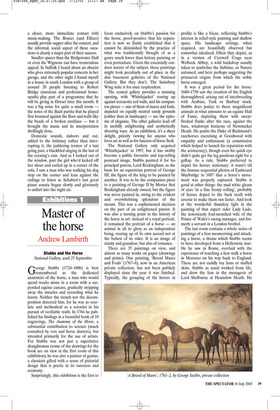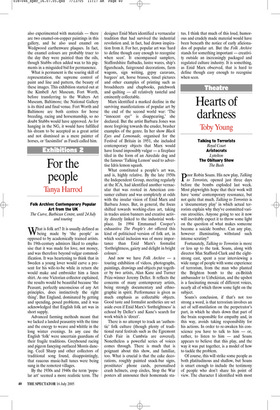Exhibitions 1
Master of the horse
Andrew Lambirth
Stubbs and the Horse National Gallery, until 25 September
George Stubbs (1724–1806) is best remembered as the dedicated anatomist of the horse, a man who would spend weeks alone in a room with a suspended equine carcass, gradually stripping away the muscles and recording what he learnt. Neither the stench nor the decomposition deterred him, for he was as resolute and methodical as a scientist in his pursuit of verifiable truth. In 1766 he published his findings in a beautiful book of 18 engravings, The Anatomy of the Horse, a substantial contribution to science (much consulted by vets and horse doctors), but intended primarily for the use of artists. For Stubbs was not just a superlative draughtsman (some of the drawings for the book are on view in the first room of this exhibition), he was also a painter of genius, a classicist gifted with a sense of pictorial design that is poetic in its sureness and economy.
Surprisingly, this exhibition is the first to focus exclusively on Stubbs’s passion for the horse, proof-positive that his reputation is now so firmly established that it cannot be diminished by the practice of what was traditionally thought of as a genre much lower than history painting or even portraiture. Given the essentially outdoor nature of the subject, these paintings might look peculiarly out of place in the dim basement galleries of the National Gallery. But they don’t. The Sainsbury Wing suite is for once resplendent.
The central gallery provides a stunning opening, with ‘Whistlejacket’ rearing up against terracotta red walls, and his companion pieces — one of them of mares and foals, depicted on equally neutral sandy grounds (rather than in landscape) — are the epitome of elegance. The other galleries lead off in usefully enlightening and aesthetically diverting ways. As an exhibition, it’s a sheer delight, priority viewing for anyone who loves art as well as for fanciers of horse flesh.
The National Gallery only acquired ‘Whistlejacket’ in 1997, but it has swiftly become a public favourite and top-selling postcard image. Stubbs painted it for his principal patron, Lord Rockingham, as the basis for an equestrian portrait of George III, the figure of the king to be painted by another. It was to be the companion piece to a painting of George II by Morier that Rockingham already owned, but the figure was never painted in, owing to the evident and overwhelming splendour of the mount. This was a sophisticated decision on the part of an enlightened patron. It was also a turning point in the history of the horse in art: instead of a royal portrait, it remained the portrait of a horse — an animal in all its glory as an independent being, rearing up of its own accord not at the behest of its rider. It is an image of clarity and grandeur, but also of romance.
There are 35 paintings on view, and almost as many works on paper (drawings and prints). One painting, ‘Brood Mares and Foals’ (1767–8), now in an American private collection, has not been publicly displayed since the year it was finished. Typically, the grouping of the horses in profile is like a frieze, reflecting Stubbs’s interest in relief-style painting and shallow space. His landscape settings, when required, are beautifully observed but somewhat idealised. Often they depict, as in a version of Creswell Crags near Welbeck Abbey, a wild backdrop usually taken to symbolise the Sublime, or Nature untamed, and here perhaps suggesting the primaeval origins from which the noble horse emerged.
It was a great period for the horse: 1680–1750 saw the creation of the English thoroughbred, arising out of interbreeding with Arabian, Turk or Barbary stock. Stubbs does justice to these magnificent animals in what amounts to an equine Hall of Fame, depicting them with sweatflecked flanks after the race, against the bare, windswept horizons of Newmarket Heath. He paints the Duke of Richmond’s racehorses exercising at Goodwood with empathy and enthusiasm (a commission which helped to launch his reputation with the aristocracy), though even his quick eye didn’t quite get the leg positions right for a gallop. As a rule, Stubbs preferred to depict his horses stationary: it wasn’t till the famous sequential photos of Eadweard Muybridge in 1887 that a horse’s movement was properly captured. Stubbs is good at other things: the mad white gleam of eyes ‘in a fine frenzy rolling’, probably of horses doped to the back teeth with arsenic to make them run faster. And look at the wonderful thundery light in the painting of that expert rider Lady Lade, the notoriously foul-mouthed wife of the Prince of Wales’s racing manager, and formerly a servant in a London brothel.
The last room contains a whole series of paintings of a lion mesmerising and attacking a horse, a theme which Stubbs seems to have developed from a Hellenistic marble he saw in Rome, overlaid with the experience of watching a lion stalk a horse in Morocco on his way back to England. These are not cuddly toy lions or stuffed skins. Stubbs as usual worked from life, and drew the lion in the menagerie of Lord Shelburne at Hounslow Heath. He also experimented with materials — there are two enamel-on-copper paintings in this gallery, and he also used enamel on Wedgwood earthenware plaques. In fact, the enamel colours are probably truer to the day they were painted than the oils, though Stubbs often added wax to his pigments in a misguided bid for permanence.
What is permanent is the soaring skill of representation, the supreme control of paint and line and pattern, the beauty of these images. This exhibition started out at the Kimbell Art Museum, Fort Worth, before transferring to the Walters Art Museum, Baltimore; the National Gallery is its third and final venue. Fort Worth and Baltimore are both centres for horse breeding, racing and horsemanship, so no doubt Stubbs would have approved. As for hanging in the NG, it would have fulfilled his dream to be accepted as a great artist and not dismissed as a mere painter of horses, or ‘facsimilist’ as Fuseli called him.



























































 Previous page
Previous page